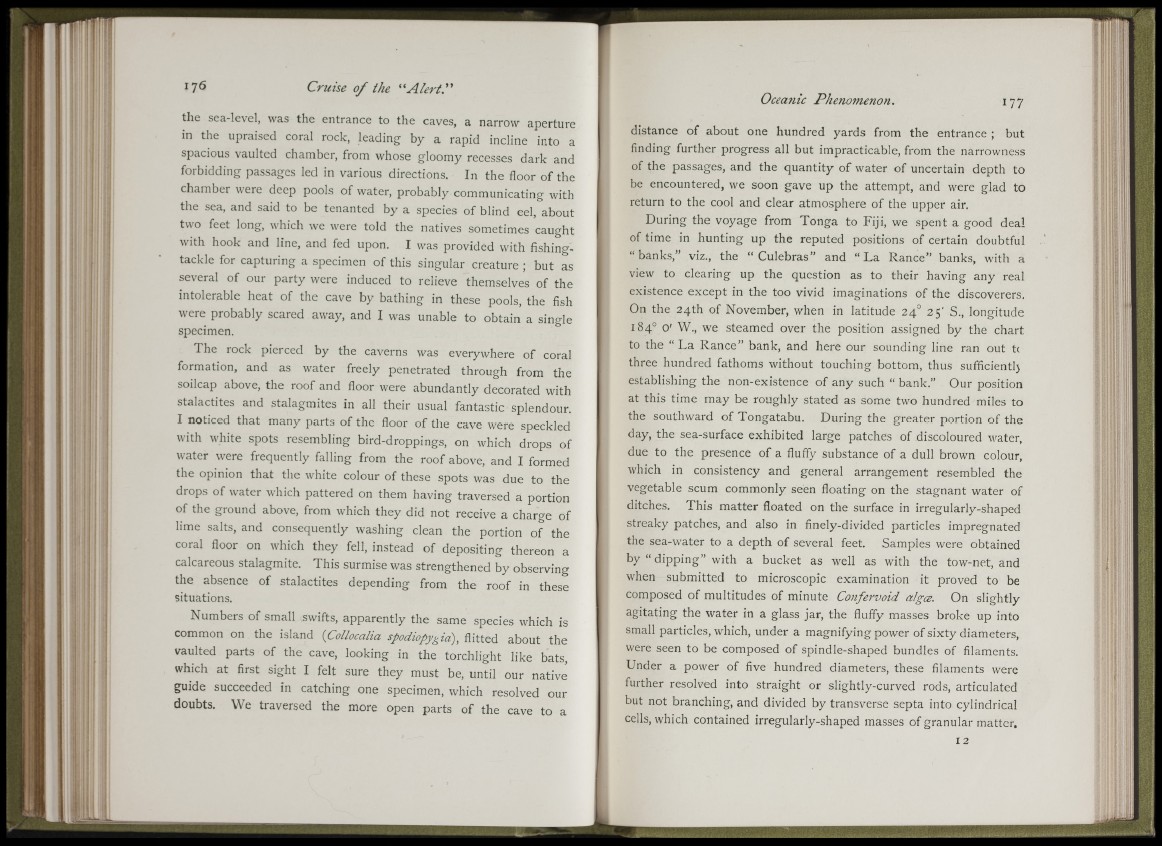
I I
the sea-level, was the entrance to the caves, a narrow aperture
in the upraised coral rock, leading by a rapid incline into a
spacious vaulted chamber, from whose gloomy recesses dark and
forbidding passages led in various directions. In the floor of the
chamber were deep pools of water, probably communicating with
the sea, and said to be tenanted by a species of blind eel, about
two feet long, which we were told the natives sometimes caught
with hook and line, and fed upon. I was provided with fishingtackle
for capturing a specimen of this singular creature ; but as
several of our party were induced to relieve themselves of the
intolerable heat of the cave by bathing in these pools, the fish
were probably scared away, and I was unable to obtain a single
specimen.
The rock pierced by the caverns was everywhere of coral
formation, and as water freely penetrated through from the
soilcap above, the roof and floor were abundantly decorated with
stalactites and stalagmites in all their usual fantastic splendour.
I noticed that many parts of the floor of the cave were speckled
with M'hite spots resembling bird-droppings, on which drops of
water were frequently falling from the roof above, and I formed
the opinion that the white colour of these spots was due to the
drops of water which pattered on them having traversed a portion
of the ground above, from which they did not receive a charge of
lime salts, and consequently washing clean the portion of the
coral floor on which they fell, instead of depositing thereon a
calcareous stalagmite. This surmise was strengthened by observing
the absence of stalactites depending from the roof in these
situations.
Numbers of small swifts, apparently the same species which is
common on the island {Collocalia spodiopygia), flitted about the
vaulted parts of the cave, looking in the torchlight like bats,
which at first sight I felt sure they must be, until our native’
guide succeeded in catching one specimen, which resolved our
doubts. We traversed the more open parts of the cave to a
Oceanic Phenomenon. 177
distance of about one hundred yards from the entrance ; but
finding further progress all but impracticable, from the narrowness
of the passages, and the quantity of water of uncertain depth to
be encountered, we soon gave up the attempt, and were glad to
return to the cool and clear atmosphere of the upper air.
During the voyage from Tonga to Fiji, we spent a good deal
of time in hunting up the reputed positions of certain doubtful
“ banks,” viz., the “ Culebras” and “ Fa Ranee” banks, with a
view to clearing up the question as to their having any real
existence except in the too vivid imaginations of the discoverers.
On the 24th of November, when in latitude 24° 25' S., longitude
184° O' W., we steamed over the position assigned by the chart
to the “ Fa Ranee” bank, and here our sounding line ran out tc
three hundred fathoms without touching bottom, thus sufficient!}
establishing the non-existence of any such “ bank.” Our position
at this time may be roughly stated as some two hundred miles to
the southward of Tongatabu. During the greater portion of the
day, the sea-surface exhibited large patches of discoloured water,
due to the presence of a fluffy substance of a dull brown colour,
which in consistency and general arrangement resembled the
vegetable scum commonly seen floating on the stagnant water of
ditches. This matter floated on the surface in irregularly-shaped
streaky patches, and also in finely-divided particles impregnated
the sea-water to a depth of several feet. Samples were obtained
by “ dipping” with a bucket as well as with the tow-net, and
when submitted to microscopic examination it proved to be
composed of multitudes of minute Confervoid alga. On slightly
agitating the water in a glass jar, the flufiy masses broke up into
small particles, which, under a magnifying power of sixty diameters,
were seen to be composed of spindle-shaped bundles of filaments.
Under a power of five hundred diameters, these filaments were
further resolved into straight or slightly-curved rods, articulated
but not branching, and divided by transverse septa into cylindrical
cells, which contained irregularly-shaped masses of granular matter.
I 2
•'B-
•' ’;{h